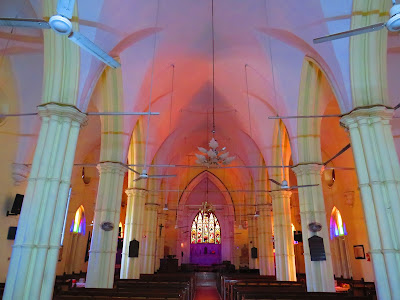St. Matthia's Church and the Cemetery of Coja Petrus Uscan
Here lies the body of the Madras Man, who immensely contributed to the causes of Armenians, whose heart lies in Julfa.
Yes! This article is about the site where the tombstone of the wealthy Armenian, Coja Petrus Uscan, who always loved his native place, is located. (Julfa was the headquarters of Armenian merchants).
Would the history of Madras be complete without mentioning this Madras Man? Uscan was the most prominent Armenian in Madras during his times. He served as the Company Councilor for the British East India Company. He constructed the steps that led to St. Thomas Mount Catholic shrine and a bridge across the Adyar river to provide a safe passage for the pilgrims to the same site. He also contributed to constructing St. Rita's Church.
Post the French invasion, the Britishers demolished the Catholic chapel inside St. George's Fort. Uscan, who lived inside the Fort, built a church for Catholics in Vepery. He named the church as Nosa Senhora de Milagre (also known as the Church of Our Lady of Miracles). Uscan died in 1751 CE and was buried in the church cemetery.
In 1752, the Catholic church was taken over by the Society for Promoting Christian Knowledge (SPCK). Danish Protestant Mission was one of the main institutions supported by SPCK. They converted this into an Anglican Church. After it was extensively repaired, it had its consecration in 1823 CE. Thus, a new church structure was constructed, partly funded by the East India Company. It was named as St. Matthia Church. John Law was the architect of the church building.
The churchyard has many tombstones. Other than Uscan's tombstone, there is another popular Madras personality, Johann Phillip Fabricius, who was buried here. Fabricius was a German missionary and Tamil scholar. He published the first Tamil to English dictionary and translated Bible in Tamil.
 |
| Tombstone of Uscan |
 |
| Tombstone of J.P.Fabricius |
The church is small in size and the architecture is very simple. It has a small tower and not a tall steeple.
The interior looks attractive with two rows of broad pillars supporting the structure. One stained glass panel is found in the center. A tablet by the architect and few new tablets are etched at the entrance. An old organ pipe and the wooden furniture enhance the elegance of the building.
A relief image depicting the scene of the Bible getting translated in Tamil is a unique one.
Some of the memorial tablets found on the interior walls of the church:
- Martha, died in 1850
- Rebecca Gordon, died in 1851
- Charles Calthrop, died in 1811
- Thomas Alexander Oakes, died in 1845
- Charles Willaim Maitland, died in 1866
- William Thomas Starkenburgh, died in 1869
- Lt. John Braddock, died in 1840
- Edward John Colin Joyes, died in 1855
- William Arthur Edwin Caudoin, died in 1901
The cemetery is poorly maintained. I could not read the names in most of the tombstones. Even the historic tombstone of Uscan was left to gather dust.
Although this church and the cemetery are historically significant, the residents of Vepery do not seem to know anything about them.
Literally, no one is bothered about the heritage value of the site.
Happy travelling.























.JPG)
Thank you for unearthing this piece of Madras history. I enjoy visiting your blog.
ReplyDeleteNice article. I worship at St.Matthias' Church since the late 1980's. Just a few suggestions, please change the spelling to "Matthias". S.P.C.K is Society for Promoting Christian Knowledge. The Danish mission is one of various initiatives and institutions which the S.P.C.K had supported then.
ReplyDeleteThank you. Changes are done as per your valid suggestions.
Delete